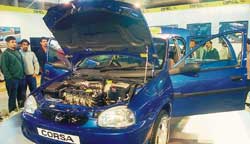Testy drive
 Opel Astra, General Motors's sleekly-modelled luxury car might be zooming on the streets, the company may have bagged the third position in the grp rating, but its environmental credentials are far from being top notch. In fact, the overall score of just 40.77 per cent, reveals its poor environmental performance as well as that of the entire industry.
Opel Astra, General Motors's sleekly-modelled luxury car might be zooming on the streets, the company may have bagged the third position in the grp rating, but its environmental credentials are far from being top notch. In fact, the overall score of just 40.77 per cent, reveals its poor environmental performance as well as that of the entire industry.
The reason for its relatively good showing in certain parameters is that this ambitious venture between General Motors Corporation and C K Birla group of companies has taken a few greening measures. The multinational has a separate environment department. Besides getting the ems certification, it targets and monitors the environmental performance more comprehensively, runs better training programmes and budgets for such activities.
But it suffers from myopic management when it comes to developing its policy goals. General Motors' environment policy lacks the drive to push for the manufacturing of environmentally sound vehicles. It is largely oriented towards improving just the production processes. Twelve per cent of the vehicles in the company's Indian stable are fuelled by diesel. The rest run on petrol.
General Motors' products rank fifth in overall product use, pitched as it is against some fancied names like Matiz, Maruti and Santro among others. Opel Astra, its more saleable model, is ranked 12th with 43.28 per cent score and Opel Corsa ranks 13th with 43.09 per cent. Both these vehicles have the highest compression ratio among all the petrol-run cars.
Though such figures might work to strengthen the company's brand equity but that the fact is the company has not planned to introduce a hybrid or alternative fuel engine. Also, it has not invested in research and development in India. Therefore, it has limited ability to adapt to the demands of the tougher Indian conditions.
And when it comes to its procurement policy and supply chain management the company ranks second with a score of 42.87 per cent. The reason for its comparatively better performance is presence of a clear policy and guideline for sourcing of materials from vendors. It has laid a guideline, which requires all its suppliers to become iso 14001 compliant within a predefined time frame. Out of its 120 local suppliers, seven are already certified, 11 are committed for certification by 2002 and rest by the following year.
In consumption efficiency the company ranks lower as it has an ambivalent record in this area of operations. Though the company manages its resources poorly with increasing trends with respect to per unit energy and water consumption, it does meet 36 per cent of its energy demands from clean gaseous fuels like lpg. However, it has not done much in making itself self-sufficient in water requirement. General Motors meets its entire water demand from groundwater, and has not envisaged water harvesting as yet.
In case of usage efficiency of consumables during various manufacturing stages, the company has registered a mixed performance. It has shown increasing trends for paint consumption but the reverse in case of primer
